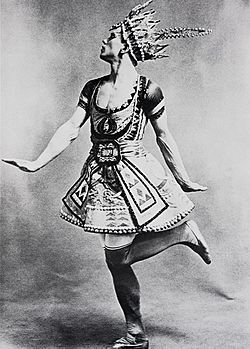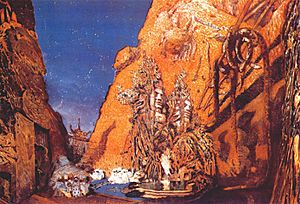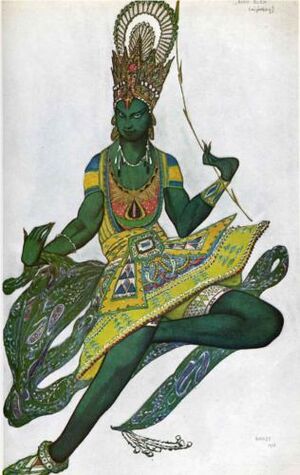Le Dieu Bleu facts for kids
Quick facts for kids Le Dieu Bleu |
|
|---|---|

Nijinsky as The Blue God
|
|
| Choreographed by | Michel Fokine |
| Composed by | Reynaldo Hahn |
| Libretto by | Jean Cocteau Federico de Madrazo y Ochoa |
| Based on | Original story |
| Date of premiere | 13 May 1912 |
| Place of premiere | Théâtre du Châtelet Paris |
| Original ballet company | Diaghilev's Ballets Russes |
| Designs by | Léon Bakst |
| Setting | India |
| Created for | Nijinsky |
| Genre | Mythology |
| Type | Neoclassical ballet |
Le Dieu Bleu (which means The Blue God in English) is a one-act ballet. It tells a story through dance. Jean Cocteau and Federico de Madrazo y Ochoa created the story. Reynaldo Hahn wrote the music. Mikhail Fokine designed the dances, and Léon Bakst made the amazing sets and costumes.
This ballet was first shown in Paris on May 13, 1912. It was performed at the Théâtre du Châtelet. Sadly, it was not a success. People who watched it, called critics, felt that Vaslav Nijinsky, the main dancer, posed more than he danced. The producer, Sergei Diaghilev, thought the music by Reynaldo Hahn was the reason it failed. Le Dieu Bleu was performed three times in Paris in 1912 and three times in London in 1913. It has not been performed since then.
Contents
How the Ballet Started
Sergei Diaghilev was a famous ballet producer. He had already created two very popular ballets. These were Cléopâtre in 1909 and Schéhérazade in 1910. Both of these ballets had an "exotic" feel, meaning they were inspired by faraway lands. Diaghilev hoped Le Dieu Bleu, which was also exotic, would be just as successful.
Le Dieu Bleu was planned as one of six new ballets for the 1911 season of the Ballets Russes. The other ballets included Narcisse and Petrushka. Mikhail Fokine was supposed to design the dances for all of them. Léon Bakst would design the sets and costumes for many.
Diaghilev moved Le Dieu Bleu to 1912. He spent a lot of money on it, even though he lost some interest. He really wanted Le Dieu Bleu to make Vaslav Nijinsky a huge international star.
Fokine started working on the dances in Saint Petersburg in 1911. He got some ideas from the dances of the Royal Siamese Court ballet. This group had performed in St Petersburg years before. Fokine also studied the art of India. However, his dances for Le Dieu Bleu ended up being a bit boring.
The music by Reynaldo Hahn might have been the problem. A critic named Prince Lieven said the music was "sweet and insipid". This means it was pleasant but not very exciting. Bakst's ideas for the sets and costumes were based on pictures from the Cambodian Ballet's performances in France.
First Performance Details
The ballet was first shown by Diaghilev's Ballets Russes. This happened in Paris at the Théâtre du Châtelet on May 13, 1912. Another ballet called Thamar was also on the program that night. Both ballets were not well-received.
Diaghilev was surprised that Thamar failed. He thought it would be as popular as Schéhérazade. He was less surprised that Le Dieu Bleu didn't do well. He secretly blamed Hahn's music for the failure. The music was not very exciting. Diaghilev felt he had to use it because Hahn had powerful friends in Paris. These friends might have stopped supporting the Ballets Russes if Hahn's music had been rejected.
Main Dancers
This ballet was specially created for Vaslav Nijinsky. He was cast as The Blue God. Diaghilev hoped this role would make Nijinsky a famous dancer around the world.
Other important dancers in the ballet included:
- Max Frohman as The Young Man
- Tamara Karsavina as The Young Girl
- Lydia Nelidova as The Goddess
- Michel Federov as The High Priest
- Nijinsky's sister, Bronislava Nijinska, as The Temple Dancer
The Ballet's Story
The story of Le Dieu Bleu takes place in India a long, long time ago. The curtain opens on a warm evening. We see a temple made of rock. In front of it is a pool with a beautiful lotus flower floating on top. Snakes and other animals are resting near the water. The temple walls are covered with many flowering plants.
People are waiting for a special ceremony to begin. A young man is about to become a priest of the temple. Suddenly, a young girl runs in. She kneels at his feet. She doesn't want him to leave her to become a priest. She dances for him, trying to make him stay.
The priests are shocked by her actions. They lead the young man away. Then, they prepare the young girl for death as a punishment. The temple gates are shut. The young girl tries to escape.
Suddenly, scary Monsters rise from a hidden trap door. Then, The Goddess appears from the lotus flower. Finally, The Blue God rises from the pool. He calms the monsters with his magical flute. The monsters become trapped by the thick plants. The Blue God's work is done.
The priests return and are surprised to see the young girl still alive. They fall to their knees before her. The young man then rejoins the young girl. The Goddess makes golden stairs appear from the sky. The Blue God flies up these stairs and disappears into the clouds.
What People Thought
Diaghilev really hoped Le Dieu Bleu would be a huge success. But it wasn't. Many people felt that Nijinsky's amazing talent was wasted in this ballet. They said he spent more time posing in beautiful positions than actually dancing.
What people liked most about the ballet were Léon Bakst's incredible sets and costumes. Valery Svetlov, a writer for the Mercure de France, wrote on May 15, 1912, that Dieu was "a failure in every sense of the word."
The ballet was performed three times in Paris in 1912. It was also shown three times in London in 1913. Years later, in April 2011, Bakst's costumes and sets were used again for a special Diaghilev Festival in London. New dances were created for it, but this new production also didn't get good reviews.



